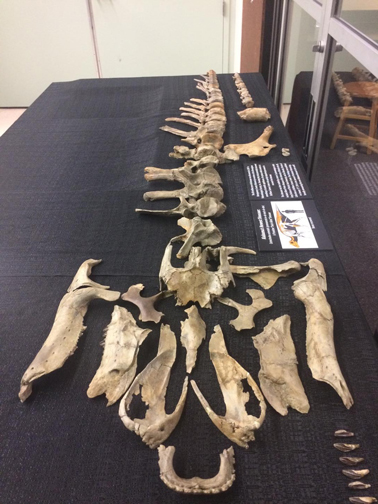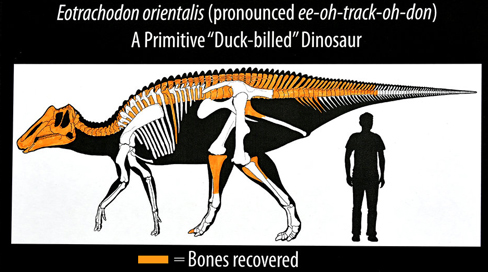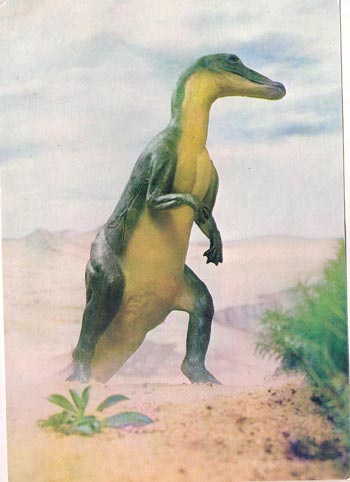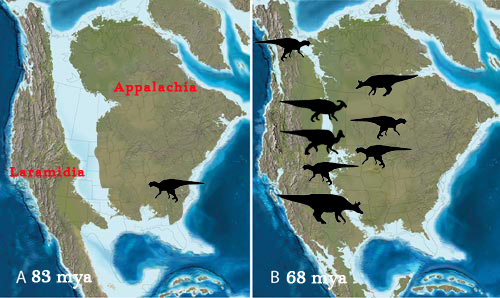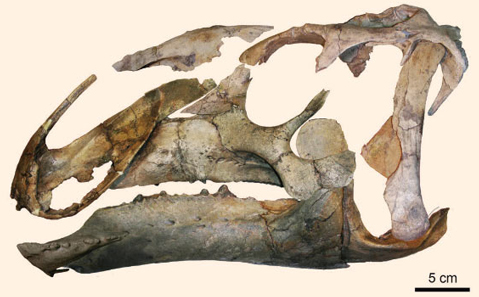New Duck-Billed Dinosaurs – Sweet Home Alabama!
Alabama Fossil Sheds Light on the Origins of Duck-Billed Dinosaurs
The duck-billed dinosaurs, or to be more precise, the Hadrosauroidea were a super-family of plant-eating, bird-hipped dinosaurs that dominated Late Cretaceous ecosystems throughout most of the northern latitudes. The fossils of these large dinosaurs, some of which evolved into the biggest facultative bipeds known to science, can be seen in museums throughout the world, but little is known about the evolutionary origins of this very successful part of the Dinosauria. However, a remarkable fossil find from Alabama (south-eastern United States), is helping to shed new light on the origins of the duck-billed dinosaurs.
The Fossils of Eotrachodon orientalis Laid Out
Picture credit: Jun Ebersole, McWane Science Centre
The beautifully preserved fossils were found by amateur fossil hunters exploring a creek in Montgomery County, Alabama, when they come across one of the bones eroding out of the soft marine sediment. Thanks to the efforts of an international team of researchers, the fossil material has been carefully prepared and it has been confirmed that these bones and the few teeth (see bottom right hand corner of the photograph), represent a new species of primitive duck-billed dinosaur.
Eotrachodon orientalis
The dinosaur has been named Eotrachodon orientalis (dawn rough tooth from the east). It is the most complete primitive hadrosaurid dinosaur ever to be found in the eastern United States.
An Illustration and Scale Drawing of E. orientalis
Picture credit: Florida State University with additional annotation by Everything Dinosaur
In Honour of Trachodon
Lead author of the scientific paper, published this week in the “Journal of Vertebrate Palaeontology”, Albert Prieto-Marquez, stated that the genus name honours Trachodon, a name that would be very well known to fans of dinosaurs.
Trachodon is the genus erected in 1856 by Joseph Leidy as a result of fragmentary bones and teeth having been excavated from the Upper Cretaceous rocks (Judith River Formation) of Montana. It was one of the very first American dinosaurs described, the first duck-billed dinosaur to be named (although some of the teeth used to describe it were later identified as ceratopsian), and although the name is now regarded as a nomen dubium (not a valid genus), Trachodon appeared in countless books about dinosaurs for the best part of 120 years. The popularity of Trachodon was helped by wonderful illustrations produced by palaeoartists such as Zdenek Burian (Trachodon and Tyrannosaurus rex).
Trachodon Became the Archetypal Duck-Billed Dinosaur
Picture credit: Everything Dinosaur
Now Trachodon has been honoured with a valid genus (Eotrachodon). At perhaps, nine metres long, Eotrachodon orientalis was certainly not the biggest, but the fossil find is extremely significant none-the-less. Firstly dinosaur fossil finds are rare from the south-eastern United States. To read an article about which U.S. States have dinosaur fossils: 37th U.S. State with A Dinosaur Fossil.
Commenting on the significance of the discovery, one of the authors of the scientific paper, Gregory Erickson (Florida State University) explained:
“This is a really important animal in telling us how they came to be and how they spread all over the world.”
Did the Hadrosaurs Originate in Appalachia?
Whilst the specimen was being prepared at the McWane Science Centre (Birmingham, Alabama), the scientists were able to piece together the skull bones and identify a modified nasal area of the skull that had, until now been regarded as a characteristic associated with saurolophine hadrosaurids (solid-crested and crestless forms). Dating the fossil to the Late Santonian faunal stage (83 million years ago), it suggests that the duck-billed dinosaurs originated on the continental landmass known as Appalachia.
During the Late Cretaceous, North America was split by into two by a wide sea (the Western Interior Seaway), Laramidia lay to the west, whilst the larger landmass of Appalachia lay to the east. Phylogenetic analysis indicates that Eotrachodon is a basal member of the hadrosaurids and thus, it can be postulated that this group of dinosaurs evolved on Appalachia. Land bridges formed as the Western Interior Seaway permitted these dinosaurs to migrate off this continental landmass and to spread to other parts of the Late Cretaceous world.
Reseracher Jun Ebersole, (McWane Science Centre), stated:
“For roughly 100 million years, the dinosaurs were not able to cross this barrier. The discovery of Eotrachodon suggests that duck-billed dinosaurs originated in Appalachia and dispersed to other parts of the world at some point after the seaway lowered, opening a land corridor to western North America.”
Fossil Find Suggests Hadrosaurids Originated from Appalachia
Picture credit: Everything Dinosaur
A View of the Left Lateral Side of the Skull
Picture credit: Albert Prieto-Marquez et al
Safari Ltd have produced several duck-billed dinosaur models. To view the Wild Safari Prehistoric World range of figures: Safari Ltd. Wild Safari Prehistoric World Figures.


